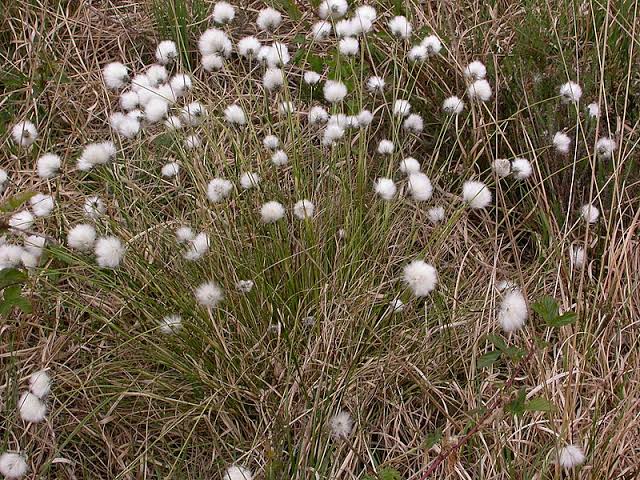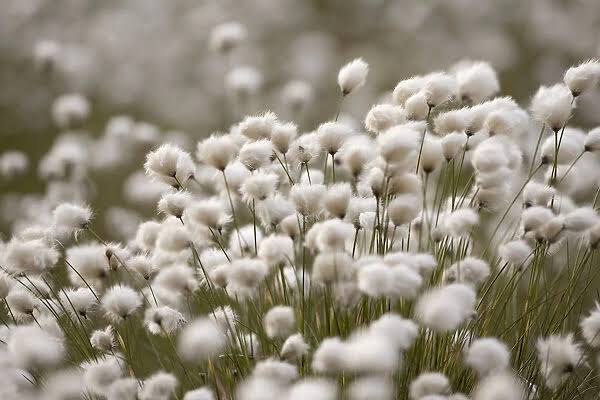Tussock cottongrass (Eriophorum vaginatum) is a remarkable plant that thrives in diverse ecosystems, particularly in wetlands and peat bogs. Its distinctive appearance and unique ecological role make it a fascinating subject for exploration.
This fluffy, white beauty is commonly found in the Northern Hemisphere, gracing regions like North America, Europe, and Asia. Its name, “Tussock cottongrass,” originates from the tufted tussocks or clumps it forms, resembling fluffy cotton balls swaying gently in the breeze.
Eriophorum vaginatum plays a vital role in these wetland ecosystems, contributing to the delicate balance of biodiversity. The plant’s specialized adaptations allow it to flourish in waterlogged conditions, showcasing nature’s incredible resilience. Its long, slender stems rise gracefully, each crowned with cotton-like tufts that serve a purpose beyond aesthetic appeal.
One of the notable features of Tussock cottongrass is its ability to disperse seeds through the wind. The fluffy tufts catch the breeze, carrying seeds across the wetland expanse, facilitating the plant’s reproduction and dispersal. This unique method ensures the continuation of Tussock cottongrass populations in its habitat.
Beyond its reproductive strategy, Eriophorum vaginatum contributes to the overall health of wetland ecosystems. The tussocks provide essential habitat and shelter for various organisms, from insects to small mammals. The dense clusters create microenvironments that support diverse flora and fauna, fostering a complex web of life.
Moreover, Tussock cottongrass plays a role in nutrient cycling within wetlands. As it grows, the plant absorbs nutrients from the water, participating in the intricate processes that maintain the ecological balance of these sensitive environments. Its presence is integral to the functioning of the larger ecosystem.
Interestingly, Tussock cottongrass has cultural significance in some indigenous communities. Traditionally, it has been used for various purposes, ranging from crafting to medicinal applications. The plant’s soft tufts have been employed in insulation and as bedding material, showcasing the resourcefulness of communities living in harmony with their natural surroundings.
Tussock cottongrass (Eriophorum vaginatum) stands as a testament to nature’s ingenuity, thriving in wetland environments and contributing significantly to the ecological tapestry. Its ethereal appearance belies its essential role in supporting biodiversity, nutrient cycling, and cultural practices. As we appreciate the delicate beauty of this plant, let us also recognize its profound impact on the intricate ecosystems it calls home.
Read Also: The Benefits and Uses of Blueberry Fruits
How To Grow Tussock Cottongrass (Eriophorum vaginatum)

Growing Tussock cottongrass (Eriophorum vaginatum) can be a rewarding endeavor, especially for those interested in cultivating unique wetland plants. Here’s a basic guide to help you grow Tussock cottongrass successfully:
1. Choose the Right Location: Select a planting site that mimics the natural habitat of Tussock cottongrass. This typically involves a wetland or boggy area with acidic soil. Ensure the site receives ample sunlight, as Tussock cottongrass thrives in sunny conditions.
2. Soil Preparation: Tussock cottongrass prefers acidic and nutrient-poor soils. Amend the soil with peat moss or well-rotted organic matter to improve water retention. Ensure good drainage to prevent waterlogging, as overly soggy conditions may be detrimental to the plant.
3. Planting: Plant Tussock cottongrass seeds or rhizomes in the prepared soil. Planting can be done in spring or fall, during periods of moderate temperatures. Ensure that the seeds are sown at the appropriate depth, typically just below the soil surface.
4. Watering: Maintain consistently moist conditions, as Tussock cottongrass naturally thrives in wet environments. However, avoid waterlogging, as excessive water can lead to root rot. Regular watering is crucial, especially during dry periods.
5. Sunlight Requirements: Provide ample sunlight to encourage healthy growth. Tussock cottongrass is adapted to open, sunny conditions, so a location with at least partial sunlight is essential for its development.
6. Fertilization: Limit fertilization, as Tussock cottongrass prefers nutrient-poor soils. Excessive fertilization may disrupt the natural balance and lead to undesirable growth patterns.
7. Maintenance: Keep the planting area free from competing vegetation. Regular weeding is essential, especially in the early stages of growth. Tussock cottongrass does well in environments with minimal competition from other plants.
8. Wildlife Considerations: Be mindful of local wildlife that may be attracted to Tussock cottongrass. The plant provides habitat for various species, contributing to biodiversity. Consider the ecological impact and ensure a balance that supports both the plant and the surrounding ecosystem.
9. Patience and Observation: Growing Tussock cottongrass may require patience, as the plant establishes itself and develops over time. Regularly observe its growth, making adjustments to watering and care as needed.
By following these general guidelines, you can create an environment that mimics the natural habitat of Tussock cottongrass, fostering its growth and contributing to the preservation of this unique wetland plant.
How To Care For Tussock Cottongrass (Eriophorum vaginatum)
Caring for Tussock cottongrass (Eriophorum vaginatum) involves providing the right conditions to support its growth and maintaining a healthy ecosystem. Here’s a guide on how to care for Tussock cottongrass:
1. Watering: Ensure consistent moisture, keeping the soil consistently damp without waterlogging. Regular watering is crucial, especially during dry periods. However, avoid standing water, as Tussock cottongrass is adapted to moist but not waterlogged conditions.
2. Sunlight: Provide ample sunlight, as Tussock cottongrass thrives in open, sunny conditions. Ensure that the plant receives at least partial sunlight for a significant portion of the day to support its growth and development.
3. Soil Conditions: Maintain acidic soil with poor nutrient content. Tussock cottongrass is adapted to nutrient-poor environments, so avoid excessive fertilization. Periodically check the pH of the soil and amend it with peat moss or other acidic materials if necessary.
4. Weed Control: Regularly remove competing vegetation to prevent weeds from overshadowing or outcompeting Tussock cottongrass. Weeding is particularly important during the initial stages of growth when the plant is establishing itself.
5. Wildlife Interaction: Be mindful of the wildlife attracted to Tussock cottongrass. The plant provides habitat for various species, contributing to biodiversity. Observe the interactions and ensure a balance that supports both the plant and the surrounding ecosystem.
6. Pruning: Minimal pruning is typically required for Tussock cottongrass. Remove any dead or damaged foliage to promote a tidy appearance. However, avoid excessive pruning, as the plant’s natural form contributes to its ecological function.
7. Monitoring Growth: Regularly observe the growth of Tussock cottongrass. Look for signs of stress or disease, and take corrective action if needed. Adjust watering or environmental conditions based on the plant’s response.
8. Ecosystem Health: Recognize the role of Tussock cottongrass in supporting the broader ecosystem. Foster a healthy and diverse environment, allowing the plant to contribute to the well-being of the wetland or bog ecosystem.
9. Respect Local Regulations: If you’re cultivating Tussock cottongrass in a natural or protected area, be aware of and adhere to any local regulations or guidelines. Respect the ecological balance of the region and avoid practices that may disrupt the natural ecosystem.
By following these care guidelines, you can contribute to the well-being of Tussock cottongrass and its surrounding ecosystem. Creating a harmonious environment that mimics its natural habitat will support the plant’s growth and preservation.
Read Also: The Benefits and Uses of Olive
The Uses of Tussock Cottongrass (Eriophorum vaginatum)

Tussock cottongrass (Eriophorum vaginatum) has several uses, both historically and in contemporary contexts. Here are some of the notable applications of this unique plant:
1. Traditional Indigenous Uses: In some indigenous communities, Tussock cottongrass has been traditionally utilized for various purposes. The soft, fluffy tufts have been employed as bedding material and insulation. Additionally, parts of the plant have been used for medicinal applications, showcasing the resourcefulness of these communities in utilizing natural resources.
2. Biodiversity Support: Tussock cottongrass plays a crucial role in supporting biodiversity in wetland ecosystems. The dense tussocks provide habitat and shelter for various organisms, including insects, small mammals, and birds. This contributes to the overall health and diversity of the ecosystem.
3. Soil Stabilization: The extensive root system of Tussock cottongrass helps stabilize the soil in wetland areas. By anchoring itself firmly, the plant aids in preventing soil erosion, especially in regions prone to water movement and fluctuation.
4. Water Quality Improvement: Wetlands, where Tussock cottongrass often thrives, act as natural filters for water. The plant contributes to water quality improvement by absorbing nutrients and potentially filtering impurities, playing a role in maintaining the health of the water in its habitat.
5. Ecological Restoration: Tussock cottongrass is sometimes used in ecological restoration projects. Its presence can be encouraged in areas where wetland ecosystems have been disturbed or degraded. By reintroducing Tussock cottongrass, efforts are made to restore the natural balance and function of these ecosystems.
6. Ornamental and Aesthetic Value: In gardening and landscaping, Tussock cottongrass is appreciated for its unique appearance. The fluffy white tufts add a distinctive and graceful element to wetland gardens or areas with soil conditions that mimic its natural habitat.
7. Educational and Scientific Studies: Scientists and researchers often study Tussock cottongrass to better understand wetland ecosystems and plant adaptations to specific environmental conditions. The plant’s characteristics make it a valuable subject for ecological research, contributing to our broader understanding of plant ecology.
8. Carbon Sequestration: Wetlands, including those where Tussock cottongrass is found, play a role in carbon sequestration. The plant’s growth and decomposition contribute to the accumulation of organic matter in the soil, aiding in the storage of carbon.
By recognizing and appreciating the various uses of Tussock cottongrass, from cultural significance to ecological contributions, we can better understand the plant’s importance in both natural ecosystems and human interactions with the environment.
Frequently Asked Questions (FAQs)
Q: What is Tussock cottongrass (Eriophorum vaginatum)?
A: Tussock cottongrass is a plant species, scientifically known as Eriophorum vaginatum, commonly found in wetlands and peat bogs in the Northern Hemisphere. It is characterized by its tufted appearance, with long stems ending in fluffy white tufts.
Q: Where does Tussock cottongrass grow?
A: Tussock cottongrass is found in various regions, including North America, Europe, and Asia. It thrives in wetland environments, particularly in acidic and nutrient-poor soils.
Q: How can I grow Tussock cottongrass in my garden?
A: To grow Tussock cottongrass, choose a wetland-like location with acidic soil and good sunlight. Plant seeds or rhizomes at the appropriate depth, maintain consistent moisture without waterlogging, and provide ample sunlight. Regularly weed the area and be patient, as the plant establishes itself over time.
Q: What is the ecological significance of Tussock cottongrass?
A: Tussock cottongrass plays a vital role in wetland ecosystems. It contributes to biodiversity by providing habitat and shelter for various organisms. The plant also aids in soil stabilization, water quality improvement, and acts as a natural filter for water in its habitat.
Q: Are there any traditional uses of Tussock cottongrass?
A: Yes, some indigenous communities have traditional uses for Tussock cottongrass. The plant’s soft tufts have been used for bedding and insulation, and certain parts of the plant have been utilized for medicinal purposes.
Q: Can Tussock cottongrass be used for landscaping?
A: Yes, Tussock cottongrass is appreciated for its ornamental value in landscaping. Its unique appearance, with fluffy white tufts, adds a distinctive and graceful element to wetland gardens or areas with soil conditions resembling its natural habitat.
Q: How does Tussock cottongrass contribute to carbon sequestration?
A: Wetlands, including those where Tussock cottongrass is found, contribute to carbon sequestration. The plant’s growth and decomposition contribute to the accumulation of organic matter in the soil, aiding in the storage of carbon.
Q: Is Tussock cottongrass used in ecological restoration projects?
A: Yes, Tussock cottongrass is sometimes used in ecological restoration efforts, especially in areas where wetland ecosystems have been disturbed or degraded. Reintroducing the plant aims to restore the natural balance and function of these ecosystems.
Read Also: Potato Farming Guide – 7 Tips to Grow Sacks Full of Potatoes
